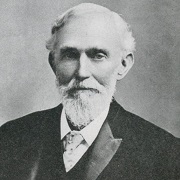| Home |

|
Capt. William M. Schrock's Civil War Regiment Monument |
Honoring the Only Company Mustered within Somerset County During the War Between the States |
See also "Pike's Peak or Bust - and Busted by
Thunder" |
 |
| Capt. William Meyers Schrock |
During the heart of the Civil War in 1863, responding to President Lincoln's call for more voluntary enlistments, William Meyers Schrock was living in New Centerville, Somerset County, PA. Within a week, he recruited 80 men to serve in a local company.
The Somerset Daily American said that "It was the only occasion during the course of the Civil War that any unit was mustered within the area of Somerset County." The new infantrymen were assembled in the flat field at what today are the grounds of the annual Farmers and Threshermens Jubilee. Among the men were five of William's step-cousins and spouses in the Younkin family.
Initially known as Capt. Schrock's Independent Company of Volunteer Infantry, it later became part of Company H of Ramsey's Battalion, Pennsylvania Infantry. The soldiers remained in New Centerville until July 6, 1863, following the Battle of Gettysburg, when they received orders to march to the nearby town of Berlin to receive weapons. They also drilled there, quartering in a vacant house on East Diamond Street.
After a few days of basic training, the men then were ordered to report to Huntingdon, PA to serve on provost duty during a military draft. In early September 1863, recounted the History of Bedford and Somerset Counties, Pennsylvania, the company marched to Harrisburg and thence to Gettysburg:
...where they guarded the field hospital on the battlefield until it was dispensed with in the latter part of October. This company was also in active service at Lewisburg, Sunbury and Selins Grove. From December 11, 1863 until January 8, 1864, the Somerset company was in charge of the Soldiers' Retreat at Harrisburg, where frequently rations were provided for from five hundred to one thousand soldiers who dropped off from trains at meal times. The company was mustered out January 8, 1864.
Many years later, on Oct. 2, 1966, the Somerset County Historical and Genealogical Society dedicated a monument to honor the company, placed on the site of the mustering ground. Local attorney Robert Keim served as master of ceremonies and Rev. Gene Abel gave the invocation, Judge Thomas F. Lansberry the principal address and Rev. Henry B. Reiley Jr. the dedication prayer. Lansberry remarked in his comments that the local recruits "had ears to hear the call of Father Abraham," said the Daily American. "This was not hearing in the ordinary sense but it was that 'inner ear' through which they heard the call that challenged them to answer the call to colors. He said that they had real courage, not the false type which causes some beatnik to throw a molotov cocktail into a store window, or causes a riot in Watts or Cleveland, but that kind of courage which sends a man through the valley of the shadow of death for the sake of a cause which he considers to be bigger than himself." Also present at the event was George Hoburn, who designed and built the monument, and Bradley Cramer, grandson of Charles Cramer who first developed the monument idea.
~ Other Younkin Family Members in Capt. Schrock's Company ~ Cunningham, George S. - husband of Sarah King of the family of Barbara (Younkin) King Enos, John - husband of Martha "Jane" Phillippi of the family of Mary Ann (Younkin) Phillippi Rush, Jacob J. - husband of Sarah Dull of the family of Frederick Dull Showman, Alexander - son of David and Jane (Younkin) Showman Swarner, Henry S. - husband of Barbara Jean Younkin |
| Monument photogaph by Linda Marker, Rockwood Area Historical Society. |
|
Copyright © 2019 Mark A. Miner |